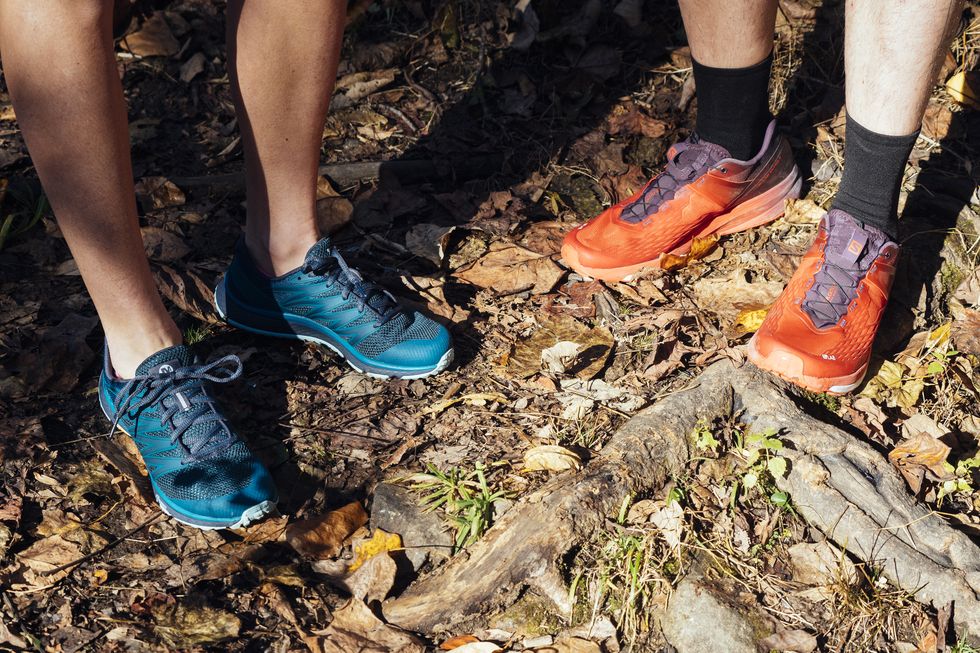Benefits of using trail running shoes on road
 When it comes to running on the road, many people assume that road running shoes are the only option. However, trail running shoes can offer several benefits for road runners as well. As an avid runner myself, I have found that using trail running shoes on the road has greatly improved my overall running experience. In this article, I will discuss the benefits of using trail running shoes on the road, considerations to keep in mind, tips for choosing the right trail running shoe for road running, and how to transition from road running shoes to trail running shoes.
When it comes to running on the road, many people assume that road running shoes are the only option. However, trail running shoes can offer several benefits for road runners as well. As an avid runner myself, I have found that using trail running shoes on the road has greatly improved my overall running experience. In this article, I will discuss the benefits of using trail running shoes on the road, considerations to keep in mind, tips for choosing the right trail running shoe for road running, and how to transition from road running shoes to trail running shoes.
Improved traction
One of the main advantages of using trail running shoes on the road is the improved traction they provide. Trail running shoes are designed with aggressive outsoles that feature multidirectional lugs, which provide excellent grip on various surfaces, including pavement.
This enhanced traction can be especially beneficial when running on wet or slippery roads, as it reduces the risk of slipping and falling. Personally, I have noticed a significant difference in my stability and confidence while running on the road with trail running shoes.
Enhanced stability
Another benefit of using trail running shoes on the road is the enhanced stability they offer. Trail running shoes are typically built with a wider base and a lower heel-to-toe drop, which promotes a more stable and balanced stride.
This can be particularly advantageous when running on uneven or unpredictable surfaces, such as cracked sidewalks or gravel roads. The added stability provided by trail running shoes can help prevent ankle rolls and other injuries, allowing you to run with greater confidence and peace of mind.
Increased durability
Trail running shoes are known for their durability, which makes them a great option for road running as well.
The rugged construction and reinforced materials used in trail running shoes are designed to withstand the harsh conditions of off-road running, making them more resistant to wear and tear compared to traditional road running shoes. This means that trail running shoes can last longer, saving you money in the long run.
Additionally, the increased durability of trail running shoes ensures that they can handle the repetitive impact of road running without losing their shape or cushioning.
Considerations when using trail running shoes on the road
 While there are many benefits to using trail running shoes on the road, it’s important to consider a few factors before making the switch.
While there are many benefits to using trail running shoes on the road, it’s important to consider a few factors before making the switch.
Less cushioning
One consideration when using trail running shoes on the road is that they typically have less cushioning compared to road running shoes. Trail running shoes prioritize protection and stability over excessive cushioning, which can be a personal preference for some runners.
If you are used to the plush cushioning of road running shoes, it may take some time to adjust to the firmer feel of trail running shoes. However, keep in mind that the reduced cushioning can actually improve your running form and strengthen your muscles over time.
Reduced responsiveness
Another consideration is that trail running shoes tend to have reduced responsiveness compared to road running shoes. This is due to the thicker and more rugged outsoles, which provide added protection but can also dampen the energy transfer between your foot and the ground.
As a result, you may feel slightly less spring in your step when running with trail running shoes on the road. However, this trade-off is often worth it for the improved traction and stability that trail running shoes offer.
Potential discomfort
Lastly, it’s important to note that using trail running shoes on the road may cause some initial discomfort, especially if you are not accustomed to their fit and design. Trail running shoes are typically more rigid and have a snugger fit compared to road running shoes.
This can take some time to get used to, and you may experience some rubbing or pressure points until the shoes break in. It’s crucial to choose the right size and ensure a proper fit to minimize any potential discomfort.
Tips for choosing the right trail running shoe for road running
 If you’re considering using trail running shoes on the road, here are some tips to help you choose the right pair:
If you’re considering using trail running shoes on the road, here are some tips to help you choose the right pair:
Look for a hybrid shoe
Consider opting for a hybrid shoe that is specifically designed for both trail and road running. These shoes often feature a combination of trail-specific features, such as aggressive outsoles and durable materials, along with road-friendly characteristics like increased cushioning and responsiveness.
Hybrid shoes provide the best of both worlds, allowing you to seamlessly transition between different terrains.
Consider the outsole design
Pay attention to the outsole design of the trail running shoes you are considering. Look for multidirectional lugs that provide excellent traction on various surfaces, including pavement.
Additionally, consider the thickness and durability of the outsole, as this will affect the shoe’s overall lifespan and performance on the road.
Check the cushioning level
While trail running shoes generally have less cushioning than road running shoes, it’s still important to find a pair that offers adequate comfort and support for your needs.
Look for shoes with sufficient midsole cushioning to absorb impact and protect your feet during road running. Remember, finding the right balance between cushioning and responsiveness is key.
Ensure proper fit
Proper fit is crucial when choosing any running shoe, and trail running shoes are no exception. Make sure to try on different brands and models to find the one that fits your feet comfortably and securely.
Consider factors such as toe box width, arch support, and heel lockdown. It’s also a good idea to consult with a knowledgeable salesperson or a podiatrist to ensure you choose the right shoe for your specific foot type and running style.
How to transition from road running shoes to trail running shoes
 If you’re ready to make the switch from road running shoes to trail running shoes, here are some tips to help you transition smoothly:
If you’re ready to make the switch from road running shoes to trail running shoes, here are some tips to help you transition smoothly:
Gradually introduce trail running
Start by incorporating short trail runs into your regular running routine. Begin with easy, well-maintained trails and gradually increase the distance and difficulty level as you become more comfortable. This gradual approach allows your body to adapt to the different demands of trail running and reduces the risk of injuries.
Focus on technique and foot placement
Trail running requires a slightly different technique compared to road running. Pay attention to your foot placement and stride length, as trails often have uneven surfaces and obstacles. Focus on maintaining a light and nimble stride, and be mindful of your surroundings to avoid tripping or twisting your ankle.
Start with shorter distances
When transitioning to trail running shoes, it’s important to start with shorter distances to allow your body to adjust to the new footwear and terrain. This will help prevent overuse injuries and give your muscles and joints time to adapt to the different demands of trail running.
Listen to your body
As with any change in running shoes or terrain, it’s crucial to listen to your body and pay attention to any signs of discomfort or pain.
If you experience persistent pain or discomfort, it may be a sign that your body is not yet ready for trail running or that the shoes are not the right fit for you. Take the time to rest and recover if needed, and consult with a healthcare professional if the pain persists.
Conclusion
 In conclusion, using trail running shoes on the road can offer several benefits, including improved traction, enhanced stability, and increased durability. However, it’s important to consider factors such as reduced cushioning, reduced responsiveness, and potential discomfort when making the switch.
In conclusion, using trail running shoes on the road can offer several benefits, including improved traction, enhanced stability, and increased durability. However, it’s important to consider factors such as reduced cushioning, reduced responsiveness, and potential discomfort when making the switch.
By following the tips for choosing the right trail running shoe for road running and transitioning gradually from road running shoes to trail running shoes, you can enjoy the best of both worlds and enhance your overall running experience.
Remember to prioritize comfort, fit, and personal preference when selecting your trail running shoes, and always listen to your body to ensure a safe and enjoyable running journey.
FAQs
Is it OK to use trail running shoes on road?
Because of the softer rubber, wearing trail-running shoes on the road, where they will regularly pound and rub on hard pavement, can wear the soles out more quickly than if you stick to the softer surface of a trail.
Can I wear my trail running shoes on pavement?
Another aspect: while yes you can run in trail shoes on roads, doing so will probably wear them out faster than if you were running in shoes designed for running on pavement. The reason is that trail shoes have soles that tend to be softer and have more ‘grip’.
Can I wear Hoka trail shoes on the road?
The HOKA Challenger ATR is a popular all-terrain running shoe that is designed for both road and trail running. It has a cushioned midsole that provides a comfortable and stable ride, and a Vibram outsole that delivers excellent traction on a variety of surfaces.
Are trail running shoes good for Travelling?
Trail shoes have cushioning in the midsole (between the insole and the outsole) that is closer to a running shoe. Perfect for comfort when you’re walking for hours in the city or out in the wilderness during your trip.
Originally posted 2023-10-31 02:59:50.
